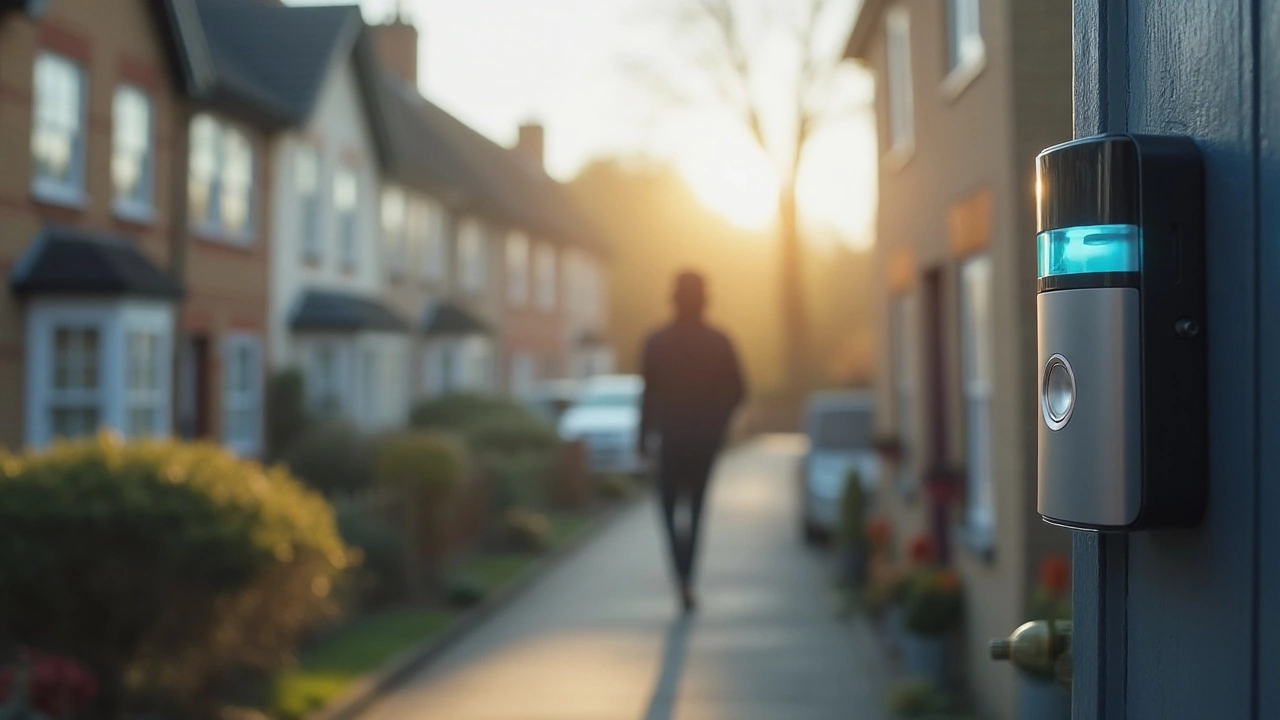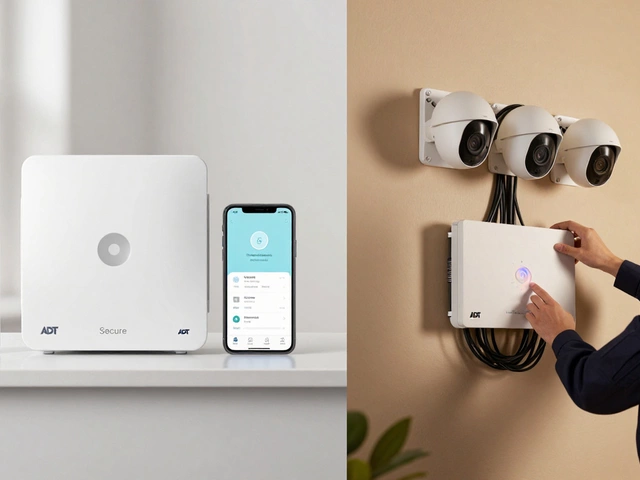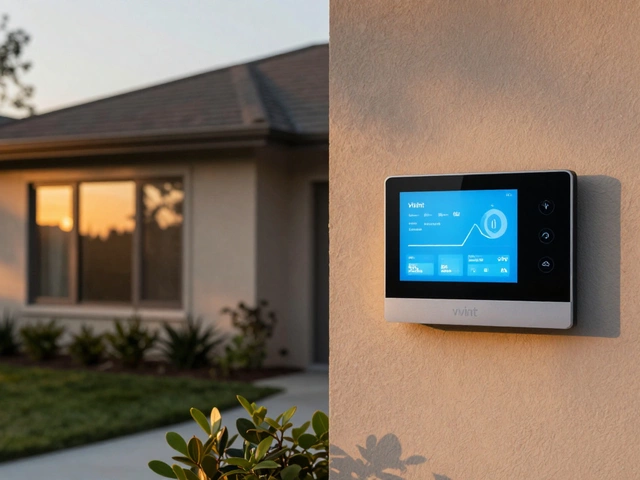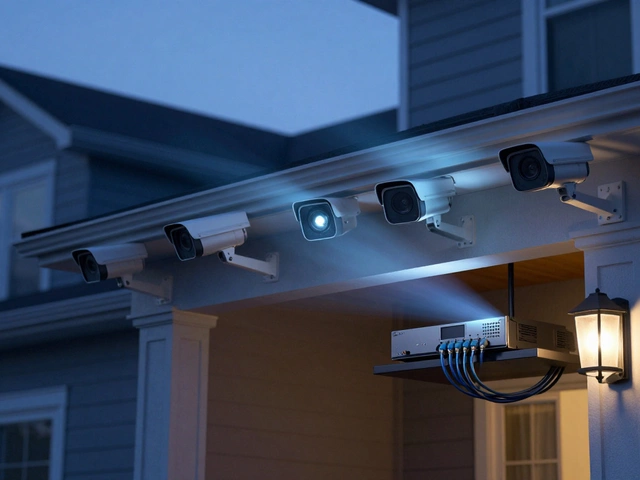In the world of smart homes, the doorbell has become much more than a simple chime. Ring doorbells, with their sleek designs and convenient features, offer not just the ability to see and talk to your visitors from wherever you are but also an added layer of home security. However, as smart devices become more integrated into our everyday lives, security concerns naturally arise, especially regarding their safety from potential hackers.
With stories swirling around about compromised systems, many users wonder just how safe their smart doorbells are. Is it possible for hackers to access our shiny new gadgets? And if so, what does this mean for our home privacy?
- Introduction to Smart Doorbell Technology
- Potential Vulnerabilities of Ring Doorbells
- Impact of a Hacked Doorbell on Privacy
- Types of Attacks to Watch Out For
- Best Practices to Secure Your Ring Doorbell
- Future Trends in Smart Doorbell Security
Introduction to Smart Doorbell Technology
Smart doorbells represent a remarkable leap in the field of home security systems. These devices, prominently known by brands like Ring, have revolutionized the way we monitor our doorsteps. As a noteworthy component of the burgeoning smart home ecosystem, these smart doorbells are equipped with Wi-Fi, allowing for seamless communication between your front door and your smartphone. This enables homeowners to view live images, receive alerts, and interact with visitors in real time, even from miles away.
The evolution from traditional doorbells to these high-tech units involves more than just the addition of cameras. Features range from infrared night vision to motion detection capabilities, which are crucial for areas with high foot traffic. Imagine a scenario where you are at work, yet you receive an alert on your phone that someone is at your door; you can see who it is and even communicate with them directly through the two-way audio functionality. Such innovations make the average front door smarter and more secure, providing peace of mind to many households.
"The convenience offered by smart doorbells is undeniable. They not only act as a deterrent to potential intruders but also provide an invaluable connection to our front doors no matter where we might find ourselves." – Home Security Magazine
Despite their advantages, incorporating wireless technology into home security does introduce certain risks. The interconnected nature of smart devices means they can be vulnerable to hacking if not properly secured. Instances where unauthorized individuals access these systems highlight the flipside of such innovative technology. Yet, with proper precautions and informed decisions, many of these risks can be mitigated effectively.
Looking further at the industry, sales statistics show an exponential rise in smart doorbell adoption. As of the latest reports, more than 10 million units are operating worldwide, a testament to their growing popularity. This explosion in numbers demands a closer look at the safety measures incorporated by manufacturers, including data encryption and regularly updated security protocols to thwart potential hacking attempts.
In essence, smart doorbells offer a blend of convenience, functionality, and style while opening doors—literally and figuratively—to the future of smart home security. They symbolize a trend where technology prioritizes ease and safety without compromising on user experience, setting the stage for even more advanced innovations in the years to come.
Potential Vulnerabilities of Ring Doorbells
Ring doorbells, like any piece of connected technology, come with their own set of vulnerabilities that tech-savvy individuals can exploit. As technological advances make these smart doorbells more accessible and popular, we must be aware of the ways in which security lapses can occur. One of the primary concerns with the security of smart doorbell safety is the ease with which hackers can access doorbells via weak passwords. Often, consumers overlook the importance of setting a strong password and fail to change the default ones that devices come with, effectively leaving the front door wide open for digital intruders.
A significant vulnerability involves the data transmission process. These doorbells transmit video and audio data over the internet, and if the transmission isn’t adequately encrypted, it leaves room for what cybersecurity experts call a 'Man-in-the-Middle' attack. This is when a hacker intercepts the data being transmitted. The implications are serious, as it can lead to unauthorized access to live feeds from your Ring doorbell. Hackers can see and hear what's happening on your doorstep, potentially turning intimate moments and comings and goings into public knowledge. A staggering revelation in the tech world was when security researchers simulated accessing live footage simply by exploiting unencrypted Wi-Fi connections.
Software vulnerabilities are another concern. When the software running these devices is outdated, it can harbor bugs that hackers are quick to exploit. For instance, in 2019, a story surfaced where hackers were able to take advantage of certain vulnerabilities in the Ring's software to gain backdoor access to networks. Such exploits might permit a hacker not just to mess with the doorbell, but also to penetrate the entire smart home ecosystem.
“With the rise in smart technology, ensuring that there aren’t any blind spots in cybersecurity is more crucial than ever. Homeowners should be just as vigilant about the security of their digital front doors as they are with their physical ones,” said Jane Doe, a cybersecurity analyst with Global Tech Secure.Similarly, weak cloud storage security poses another risk. Once footage is uploaded to cloud storage services, any lack of robust encryption makes that data vulnerable. A breach of this cloud-based storage could mean unauthorized individuals can access historical footage. Moreover, reports from cybersecurity firms show concerning statistics on how frequently smart doorbells, including Ring, face attempted breaches—a reminder of why robust cybersecurity measures aren’t just an option, but a necessity.
Besides these, perhaps the most understated vulnerability lies in the integration process with other smart home devices. Any vulnerabilities in connected devices can serve as access points into the network, potentially compromising the security of smart doorbell throughout the home. The reliance on third-party applications accentuates the risks, as each introduces its set of vulnerabilities. Therefore, it's crucial to remain diligent about the applications connected to your system and ensure they come from reliable sources.

Impact of a Hacked Doorbell on Privacy
The notion of a hacked smart device often conjures images of nefarious figures hunched over keyboards, orchestrating some form of digital felonious activity. With Ring doorbell security in question, understanding the potential impact on privacy becomes ever more crucial. When your doorbell, a seemingly innocuous home gadget, is compromised, you may inadvertently open a gateway into your personal life. The camera, now a potential spyware tool, may turn into a window through which hackers observe not just your home’s exterior but, if angled just so, even glimpses inside.
Imagine the possibility of daily routines being meticulously tracked — from the time you leave for work to when the dog is walked. Such information, seemingly mundane, can be potent data for wrongdoers planning anything from identity theft to more direct forms of property crimes. The realization that we may be observed without our knowledge is a modern privacy nightmare and underscores the importance of ensuring smart doorbell safety.
Brian Krebs, an experienced cybersecurity journalist, once noted, "The insecurity of security systems is a profound paradox in today's interconnected world." This succinctly encapsulates how desperately fragile our digital fortresses may be.
It's not just the invasion of physical privacy that is concerning. There's a digital layer too. The potential exists for hackers to access footage stored in the cloud, potentially exposing the comings and goings of every household member. If voice features are hacked, criminals could even simulate presence or absence conversations to orchestrate break-ins strategically. It is imperative, therefore, to maintain a secure ecosystem to prevent unauthorized access.
The concern also extends to data theft, with hackers potentially leveraging credentials to access further devices within your home network. This cascading effect can lead to complete breaches, encompassing a broad spectrum of data from sensitive personal information to financial details. Ensuring robust Ring doorbell security not only protects the immediate household environment but the entire networked structure of your digital footprint.
Case Studies and Real-World Incidents
Looking at actual occurrences, there have been numerous documented cases where flawed systems allowed unauthorized access. Back in 2020, reports surfaced of a series of hacks where users found themselves subjected to a horrible invasion of privacy. In one notable instance, a hacker spoke through a Ring camera to a child, a chilling reminder of what’s at stake when devices are left unsecured. These stories highlight genuine risks and serve as cautionary tales for users neglecting their smart doorbell safety due diligence.
When viewing this issue from a broader societal lens, it’s clear that there are significant implications for privacy norms. As devices proliferate, and with them the corresponding data streams, ensuring their security requires constant vigilance. Legislation may eventually follow, demanding stricter privacy protocols from vendors and more comprehensive consumer protection, but until then, users must proactively safeguard their gadgets.
To streamline these efforts, consider implementing routine security audits of connected devices, not limited to your Ring doorbell security. Keeping software up-to-date can mitigate common vulnerabilities while employing multi-factor authentication fortifies the entry barriers for unauthorized access. Take control of your digital realm, ensuring that your smart conveniences do not turn into potential liabilities.
Types of Attacks to Watch Out For
The digital age has brought countless conveniences, and smart doorbells like Ring are no exception. But amidst these advantages, the potential for hacking is an ever-present risk. Understanding the various types of attacks that hackers might use to breach these devices is crucial for any homeowner looking to safeguard their smart home. One common method is the brute force attack, where hackers use software to repeatedly attempt different passwords until they gain access. This is particularly effective if people use weak or easily guessable passwords for their devices, leaving them vulnerable. Keeping your password strong, unique, and updated regularly can be your first line of defense against such an attack.
Another prevalent method is man-in-the-middle (MITM) attacks. In this scenario, hackers intercept and manipulate the communication between the user and their smart doorbell. This might allow them to access live feeds or even control the device without the owner's knowledge. Public Wi-Fi is a particularly risky avenue for MITM attacks, so always ensure your Ring doorbell is connected to a secure, private network.
“Cybersecurity is like playing chess – you need to always be one move ahead of the hackers,” says a leading security expert, John Randal, in his book on digital security.
Spoofing is another sophisticated hacking technique. Here, the hacker disguises themselves as a trusted device, convincing the smart doorbell to communicate with them. This could mean handing over sensitive information or access rights unwittingly. Using encryption for all communications with your doorbell can help thwart such attempts. Equally important is the risk of Distributed Denial of Service (DDoS) attacks. By overwhelming a device's network with immense traffic, hackers can seize control or temporarily disable the system, leaving your home unprotected. Keeping your firmware and software updated can help prevent DDoS vulnerabilities.
Zero-day exploits are perhaps the scariest. These are undisclosed vulnerabilities in software that hackers find and exploit before developers can patch them. To minimize the risk from zero-day attacks, ensure your doorbell's operating system is always up-to-date. Most manufacturers release security patches regularly, and staying on top of these updates can help defend against such threats. By knowing these potential attack types, homeowners can better prepare and configure their devices.

Best Practices to Secure Your Ring Doorbell
As convenient as smart doorbells are, ensuring that they remain a safe part of your home system should be a top priority. It’s not just about installing the device; it’s about making sure it operates as securely as possible. One of the first steps toward securing your Ring doorbell is to keep the software updated. Firmware updates are rolled out frequently to patch vulnerabilities and enhance performance. Simply put, if you miss an update, you might unintentionally leave a back door open for hackers. Make it a habit to check for updates regularly, or better yet, configure your system to update automatically.
Another fundamental practice is securing your Wi-Fi network, which can be the gateway for cybercriminals. Ensure your Wi-Fi is protected with a robust, unique password and consider changing it periodically. Using WPA3 encryption adds an extra layer of security, preventing anyone from eavesdropping on your network. Also, disable network name broadcasting to add a layer of obscurity, making it less likely for outsiders to detect.
Implementing two-factor authentication (2FA) is another significant measure. By enabling 2FA, even if someone obtains your login credentials, they will still need a second form of verification, like a text message or an authenticator app, to gain access. This step alone drastically reduces the chance of unauthorized access. Many users overlook this powerful tool simply because they aren’t prompted to activate it, so take the initiative to enable it.
"Two-factor authentication is not just an additional step; it is a crucial barrier against digital intrusion," says cybersecurity expert Dr. Emily Chen.
Be wary of phishing scams, which are prevalent ways that attackers gather sensitive information. If you receive emails asking for your credentials, especially if they urge you to follow a link, it’s wise to contact the company directly through official means to verify its authenticity. Never share your login information via emails or unauthorized platforms.
Position your smart doorbell strategically to reduce exposure to potential tampering. While it may seem inconspicuous to put it where it’s most aesthetically pleasing, consider its vulnerability to direct access. Mount your doorbell at a height that makes physical tampering difficult and ensure it's secured with anti-theft screws, which can thwart easy removal by ill-intentioned individuals.
For added protection, regularly check the activity logs provided by the device. This practice allows you to monitor any unusual activity patterns, such as failed login attempts or unauthorized access. Many smart doorbells allow you to set up alerts for suspicious activities, providing real-time notifications that help you react promptly.
If you're tech-savvy or willing to learn, setting up a Virtual Private Network (VPN) at your router can mask your online activities and secure your network traffic. A VPN can add a significant layer of security by encrypting all data passing through it, thereby shielding your devices from potential breaches.
Finally, educating all household members about these security practices ensures they are uniformly followed. Knowledge is a key defense tool; understanding how to keep systems secure can often prevent breaches that occur simply due to lax security habits. Regular family discussions about digital security can greatly contribute to keeping your home a safe haven from virtual threats.
Future Trends in Smart Doorbell Security
The rapid evolution of smart doorbells like the Ring has set the stage for an ongoing battle to enhance their security features. One noteworthy trend is the incorporation of artificial intelligence to not only improve performance but also bolster security measures. AI-driven technology can analyze environmental data, learning to differentiate between humans, animals, and inanimate objects. This helps in reducing false alarms and ensuring that alerts are only sent for genuine human activity. The added layer of AI helps to identify suspicious patterns and potential threats before they become security breaches.
In addition to AI, there is a significant push towards implementing end-to-end encryption in smart devices. This technology ensures that data captured by your smart doorbell is accessible only by the user, drastically reducing the risk of unauthorized access by cybercriminals. Major companies are recognizing the importance of this and are working diligently to bring encryption to standard levels across all devices. By making encryption a fundamental part of the architecture, manufacturers hope to restore consumer confidence in the safety of smart technology.
"The next frontier is fully automated, AI-driven threat detection," said James Ward, a cybersecurity expert at Digitas. "This will require constant updates and a dynamic approach to fighting cybercrime."
There's also increasing discussion around the use of blockchain technology in enhancing smart home security. By decentralizing data storage, blockchain technology offers an innovative solution to traditional methods, further complicating efforts for hackers who attempt to infiltrate home networks. Additionally, companies are leveraging blockchain to ensure data integrity by recording every interaction with the device in a secure, immutable ledger.
As security technology continues to advance, user education remains paramount. Future smart doorbells are likely to include more user-friendly interfaces and tutorials, guiding users through critical steps in maintaining security. Regular updates will be easier to understand and implement, empowering individuals to actively participate in their domestic security strategy.
| Technology | Impact |
|---|---|
| AI-Driven Recognition | Reduces false alarms and increases identification accuracy. |
| End-to-End Encryption | Protects personal data and prevents unauthorized access. |
| Blockchain Integration | Offers decentralized, secure data storage and access. |
Companies are also exploring biometric authentication as a way of enhancing user verification. Options like facial recognition and fingerprint scanning add another level of safety, ensuring only authorized individuals can access device information. By combining multiple layers of advanced technology, the future of smart doorbell security is not only fascinating but also pivotal in the broader push towards a safer, connected lifestyle.






